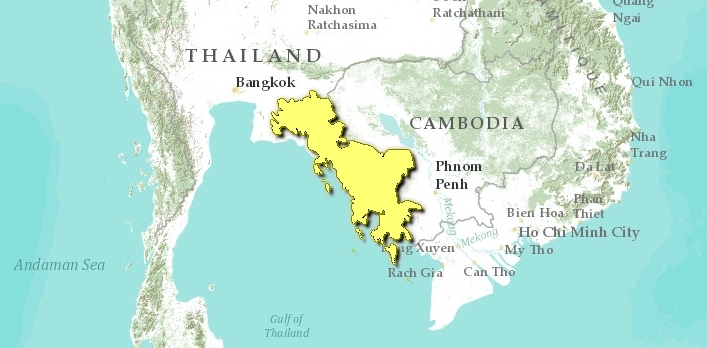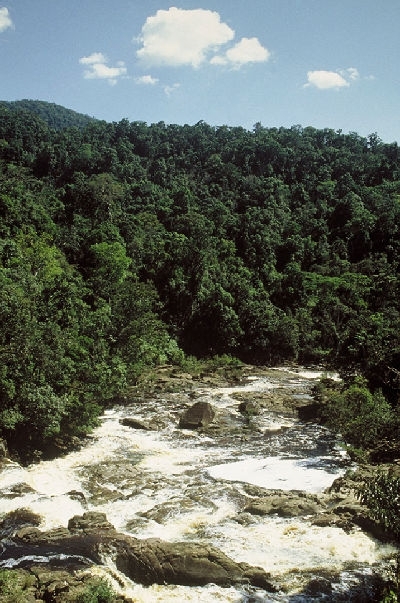Cardamom Mountains rainforests
The Cardamom Mountains rainforests ecoregion sits astride the Cardamom Mountains (locally known as Kravanh) and the Elephant Range (locally known as Dom rei) in southwestern Cambodia and extends slightly across the border into southeastern Thailand. The length of the Caramom Range is approximately 300 kilometres. It is separated from the nearest other rainforest by the vast, dry Khorat Plateau in central Thailand to the north and east and by the Gulf of Thailand in the west. The Cardamom Mountain rainforests are considered by some to be one of the most species-rich and intact natural habitats in the region, but they are also one of the least explored. Although scientific explorations have begun to reveal the unique biological riches in other intact and hitherto unexplored rainforests such as in the Annamite Mountain Range, the Cardamom Mountains have been neglected until recently. It would not be surprising if this ecoregion, which contains the essential ingredients for speciation (i.e., isolation, moist and stable conditions, intact and undisturbed habitat, and rugged terrain), yields a number of new species that will add to its biological diversity.
Location and general description

The ecoregion represents the original extent of the wet evergreen forests that cover the Cardamom and Elephant mountains in southwest Cambodia and along the mountains east of Bangkok, in Thailand. The small Dao Phu Quoc Island, which belongs to Vietnam but is just off the southern coast of Thailand, is also included in this ecoregion.
The mountain range rises from sea level to more than 1500 meters (m) to intercept and extract the moisture from the monsoon winds. The orientation of their topography along the Gulf of Thailand produces unusually wet conditions of 3000-4000 millimeters (mm) annual rainfall on the southwestern slopes of these ranges, and only a short dry season occurs. The mean annual rainfall total exceeds 5000 mm in the Emerald Valley near Bokor in the Elephant Range, whereas Kirirom, more distant from the coast in this range, receives about 2000 mm annually. These ranges are largely Mesozoic sandstone, with localized areas of limestone and volcanic rock. Younger basalts in these ranges have produced rich supplies of gemstones (rubies, sapphires, and zircons). Also included in the ecoregion is the northeastern part of this mountain unit, composed of granite ridges that reach a maximum elevation of 1,813 meters at Phnom Aural, the highest point in Cambodia. These ranges rise rapidly from the coast, leaving only a narrow coastal plain. They gently grade down into the interior lowlands to the north and northeast.
The ecological and floristic composition of these wet evergreen forest communities is poorly studied, and there would undoubtedly be recognizable communities within this association were it better known and investigated. From limited available data, local endemism appears to be significant. One of the most abundant canopy species in wet evergreen forests is Hopea pierrei, a small tree of limited distribution outside of this area. Other dipterocarps once formed the dominant canopy elements of a tall evergreen forest in [[coast]al area], with Shorea hypochra, Anisoptera costata, Dipterocarpus costatus, and Hopea odorata all abundant. Also important as canopy trees in this area were Parkia streptocarpa, Heritiera javanica, Swintonia pierrei, and Syzygium cinereum. These forests have largely disappeared today.
In addition to typical lowland evergreen rainforests, the southern slopes of the Elephant Mountains support an unusual dwarf rainforest community reaching no more than 12 meters height in areas of poorly drained depressions. The dominant species in these waterlogged sites typically are Dacrydium elatum and Podocarpus neriifolius, with a scattered distribution of P. (Nageia) fleuryi and P. (Dacrycarpus) imbricatus.
Upper elevation areas above about 700 meters in the Cardamom and Elephant Mountains contain a distinct montane forest community. These forests are structured with dense evergreen tree canopies reaching up to 30 meters in height. The Fagaceae are notably dominant, including Lithocarpus cambodienseis, L. guinieri, L. farinulenta, L. harmandii, and Castanopsis cambodiana. Also important are species of Lauraceae (Cinnamomum and Litsea) and Myrtaceae (Syzyngium and Tristania), whereas legumes are less common. There is a rich understory in these habitats, with shrubs of Rubiaceae and Euphorbiaceae, palms (Arenga pinnata and Pinanga cochinchinensis), arborescent ferns (Cibotium, Cyathea, and Oleandra), Pandanus, and Araliaceae. Epiphytes, most notably orchids, may often be abundant, particularly in sites that receive frequent fogs or mists.
A distinctive dwarf forest 5-10 meters in height is present on the acid and skeletal soils on the sandstone plateau of the southern Elephant Mountains. This community typically is dominated by Dacrydium elatum, with another conifer, Podocarpus (Dacrycarpus) imbricatus, also commonly present. Other important associates in this dwarf forest are a variety of Fagaceae and Myrtaceae, Vaccinium viscifolium, and Schima crenata. On ridgelines or other areas habitually exposed to strong winds, this community reaches no more than 5 meters height. Sphagnum bogs are also present.
A prominent area of Pinus merkusii occurs on the Kirirom Plateau in the Elephant Range, where P. merkusii grows with Dipterocarpus obtusifolius, Rhodomyrtus tomentosa, Phyllanthus officinalis, and a variety of Melastomataceae and Rubiaceae.
Biodiversity features
|
Table 1. Endemic and Near-Endemic Mammal Species. Family Common Name Species Phasianidae Chestnut-headed partridge Arborophila cambodiana Phasianidae Siamese partridge Arborophila diversa The Cardamom Mountains rainforests ecoregion is one of the few ecoregions (Cardamom Mountains rainforests) in Indochina with intact rainforests that still have potential for landscape-level conservation actions. Natural disturbance regimes and large predator-prey interactions still occur. Much of the ecoregion's biota probably remains intact. This combination of factors makes the ecoregion unique in Indochina. The ecoregion is considered to harbor more than 100 mammal species. There are no known ecoregional endemics. Nevertheless, there are several threatened species, including the endangered tiger (Panthera tigris), Asian elephant (Elephas maximus), clouded leopard (Pardofelis nebulosa), dhole (Cuon alpinus), gaur (Bos gaurus), banteng (Bos javanicus), khting vor (Pseudonovibos spiralis), pileated gibbon (Hylobates pileatus), and serow (Capricornis sumatraensis). It is possible that several large mammals that have disappeared from Indochina's forests—for example, the Sumatran (Dicerorhinus sumatrensis) and Javan rhinoceros (Rhinoceros sondaicus)—may still find safe haven in these forests. The elephant population in the Cardamom and Elephant ranges is widely considered to be the most important in Cambodia and among the largest in Indochina, although surveys are necessary to confirm this assertion. These intact forests were also recognized as a Level I TCU, where the large habitat areas allow the predator-prey dynamics associated with tigers to occur under undisturbed conditions. The Cardamom Range probably harbors the highest density of pileated gibbons throughout the species' distributional range. The bird fauna is estimated at more than 450 species and includes 2 strict endemic species (Table 1). However, in all probability many more endemic species will be added to this list after more comprehensive surveys. Recent surveys conducted by Flora and Fauna International (FFI) have found a population of the critically endangered Siamese crocodile (Crocodylus siamensis) and several other small mammals and amphibians. ==Ecoregion status== {| style="width: 440px" border="1" cellpadding="3" align="right" ! colspan="3" align="center" | Table 2. Protected Areas that Overlap with the Ecoregion. Protected Area Area (km2) IUCN Category Aural 2,420 IV Kirirom 250 II Phnom Bokor 1,580 II Ream 140 II Botum-Sakor 1,520 II Dong Peng 150 VIII Peam Krasop 80 IV Roniem Daun Sam 1,980 IV Khao Ang Ru Nai 1,030 IV Khao Soi Dao 720 IV Khao Chamao-Khao Wong 80 II Khao Khitchakut 70 II Samlaut 630 VIII Namtok Phlui 100 II Phnom Samkos 3,170 IV Mu Ko Chang 660 II Total 14,580 Because of the low human population of this ecoregion (Cardamom Mountains rainforests) , the forests in Cambodia are relatively intact; however, the areas in southeastern Thailand have been greatly reduced and now exist only in a few protected areas in hilly regions. Sixteen protected areas cover about 14,500 square kilometres (33 percent) of the ecoregion (Table 2). Six of these protected areas—Aural, Phnom Bokor, Botum-Sakor, Roniem Daun Sam, Khao Ang Ru Nai, and Phnom Samkos—are larger than 1000 km2. Phnom Samkos National Park exceeds 3,000 km2. ==Types and severity of threats== Despite this high level of formal protection, very few reserves have effective management and workforces; they are paper parks. Several are now under threat from illegal logging operations and from adjacent concessions that encroach on the unprotected protected areas. The wildlife trade has also resulted in widespread hunting throughout Cambodia and Thailand, exacting a heavy toll from endangered wildlife [[population]s]. The widespread presence of antipersonnel land mines pose severe threat to both wildlife and humans (including researchers). ==Justification of ecoregion delineation== The large Indochina biounit identified by MacKinnon in his analysis of conservation units in the Indo-Malayan realm comprises three subunits that represent the vegetation in the tropical lowland plains, subtropical hills, and temperate montane areas. The largest of these subunits, Central Indochina (10a), is a mix of tropical moist and tropical dry forests. Adjacent to this is the Cardamom Mountains subunit, which also includes the freshwater swamp forests and mangroves of the Chao Phraya river and estuary. We extracted the tropical wet evergreen vegetation that covers the Cardamom and Elephant mountain ranges and represented it with the Cardamom Mountains rainforests. The swamp forests, dry forests, and mangroves were assigned to separate [[ecoregion]s]. ==References== * Conifers of Cambodia, Lao PDR and Vietnam. 2010. Science/Genetics & Conservation/Conifer Conservation. Royal Botanic Garden, Edinburgh, Scotland. |
|---|

2 Comments
C Michael Hogan wrote: 06-02-2013 15:15:22
The location of the Cardamom Mountains in Cambodia and Thailand is in the first paragraph. I have added a note on the linear extent of the range.
Soknet Sreng wrote: 12-09-2012 10:10:23
Thank u. Can u please specify the area of Cardamom mountains located in Cambodia?